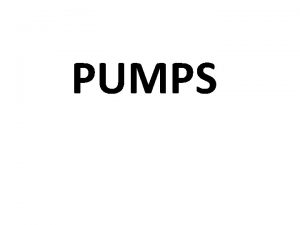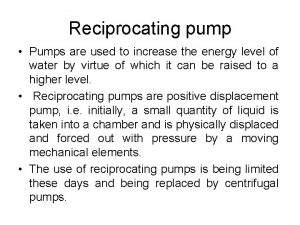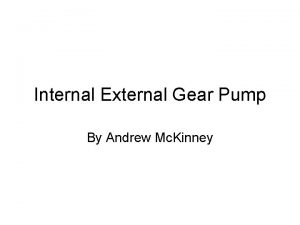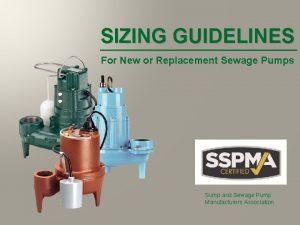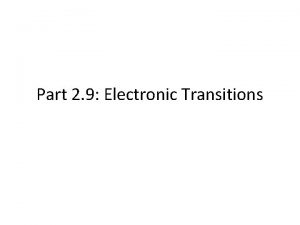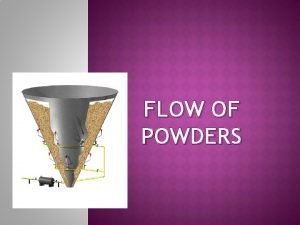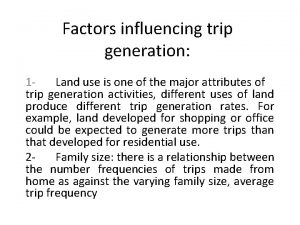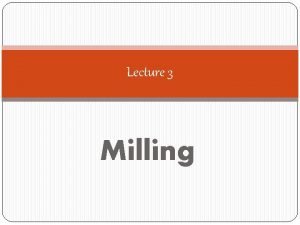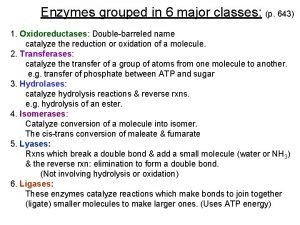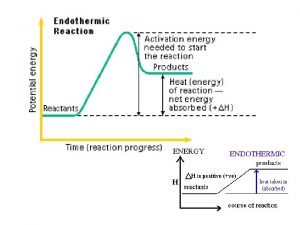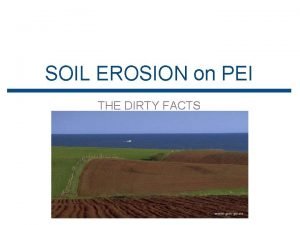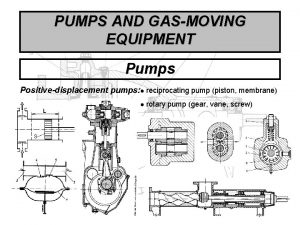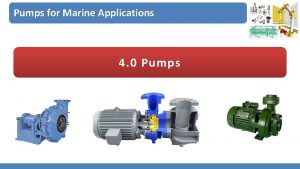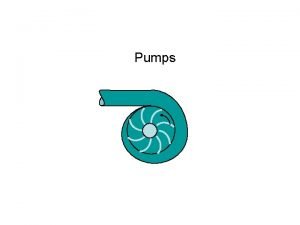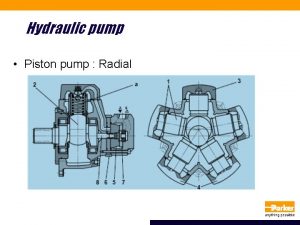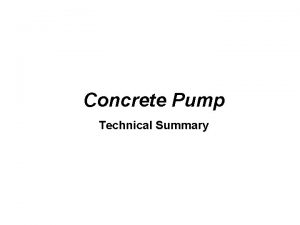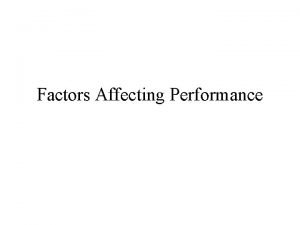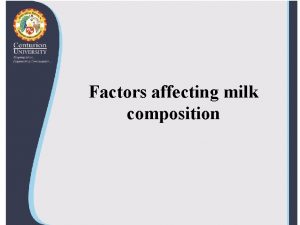PUMPS Factors Affecting Pump Selection 1 The amount





































- Slides: 37

PUMPS

Factors Affecting Pump Selection 1. The amount of fluid that must be pumped. 2. The properties of the fluid. 3. The increase in pressure of the fluid due to the work input of the pumps. 4. Type of flow distribution. 5. Type of power supply. 6. Cost and mechanical efficiency of the pump.

CENTRIFUGAL PUMPS Definition: A pump which uses centrifugal force to develop velocity in the liquid to be handled. The velocity is then converted to pressure as kinetic energy is decreased. Centrifugal pumps main components: Centrifugal pumps basically consist of: 1. Stationary pump casing 2. Impeller mounted on a rotating shaft 3. Suction line 4. Discharge line



Pump casing may be (one fabricated piece) or split casing (two or more parts together)

Classification of Centrifugal Pumps 1. According to the pump casing Volute Centrifugal Pump

Diffuser Centrifugal Pump

Diffuser Centrifugal Pump

2. According to the impeller type Open impeller Semi open impeller Enclosed impeller

To aid in understanding the pump details and to see the semi closed impeller

Single Suction and Double Suction Impellers

3. Classification by Flow Centrifugal pumps can be classified based on the manner in which fluid flows through the pump. The manner in which fluid flows through the pump is determined by the design of the pump casing and the impeller. The three types of flow through a centrifugal pump are: A. Radial flow, B. Axial flow, C. Mixed flow.




Multi-stage Centrifugal Pumps

Multi-stage Centrifugal Pumps

Centrifugal Pump Components Centrifugal pumps vary in design and construction from simple pumps with relatively few parts to extremely complicated pumps with hundreds of individual parts. Some of the most common components found in centrifugal pumps are: 1. wearings, 2. stuffing boxes, 3. packing, and 4. lantern rings.




The packing material may be: Asbestos, Nylon, Teflon, Lead, Copper or Aluminum Stuffing box and packing





Simple View for Lantern Ring and Stuffing Box

Mechanical Seals ØWhat are mechanical seals ØComponents of mechanical seals ØTypes of mechanical seals ØAdvantages and disadvantages of mechanical seals


Mechanical Seals ØUsed when packing material is not adequate for sealing the shaft. ØMechanical seals consist of two basic parts (faces), a rotating element attached to the pump shaft and a stationary element attached to the pump casing. ØOne of these element is called the sealing ring and is held in position by a spring. The other sealing element which is in contact with the sealing ring is called the mating ring. ØEach of these elements has a highly polished sealing surface. ØThe polished faces of the rotating and stationary elements come into contact with each other to form a seal that prevents leakage along the shaft.

Types of Mechanical Seals A. The rotating mechanical seal The sealing ring and the spring are rotating with the shaft and the mating ring is held stationary in the pump casing.

The rotating mechanical seal

B. Stationary Mechanical Seals ØThe sealing ring is held stationary within the pump housing. ØThe mating ring is fastened rigidly to the shaft. As the pump shaft turns so does the mating ring. ØThe stationary sealing ring bears against the rotating mating ring and leakage between the two faces is prevented.

Stationary Mechanical Seals

Advantages of Mechanical Seals ØThey require much less maintenance ØThey reduce leakage to a minimum ØThey can be designed to work under very high temperatures and pressures Disadvantages ØThey have greater capital cost than packing ØWhen they fail, pump must be stripped down for service for longer period to replace or repair seal.

 Pump selection factors
Pump selection factors Factors affecting selection of bridge site
Factors affecting selection of bridge site What factors influence satiety?
What factors influence satiety? Screw gear pump
Screw gear pump Double reciprocating pump
Double reciprocating pump External gear pump vs internal gear pump
External gear pump vs internal gear pump Sewage pump sizing
Sewage pump sizing Laporte selection rule is not affecting
Laporte selection rule is not affecting Powder flow measurement techniques
Powder flow measurement techniques Factors affecting job design
Factors affecting job design No. of pins attracted
No. of pins attracted Factors influencing trip production
Factors influencing trip production Factors in communication process
Factors in communication process Calculating time of death using rigor mortis
Calculating time of death using rigor mortis Factors affecting country risk analysis
Factors affecting country risk analysis Insight learning psychology definition
Insight learning psychology definition Explain the factors affecting learning
Explain the factors affecting learning Factors affecting milling process
Factors affecting milling process Factors affecting enzyme activity slideshare
Factors affecting enzyme activity slideshare Factors affecting equilibrium
Factors affecting equilibrium Factors affecting absorption of drug
Factors affecting absorption of drug Factors affecting transpiration graphs
Factors affecting transpiration graphs Ocean currents
Ocean currents Zeroth order kinetics
Zeroth order kinetics Media selection and scheduling
Media selection and scheduling Factors regulating cardiac output
Factors regulating cardiac output Factors affecting friction
Factors affecting friction Equity international management
Equity international management Manegerial functions
Manegerial functions Physical factors affecting sports performance
Physical factors affecting sports performance Factors affecting criminal behaviour legal studies
Factors affecting criminal behaviour legal studies Iron absorption
Iron absorption Equilibrium chemistry
Equilibrium chemistry Soil loss estimation
Soil loss estimation How do intermolecular forces affect solvation?
How do intermolecular forces affect solvation? Objective of good plant layout
Objective of good plant layout Factors affecting on solubility
Factors affecting on solubility Factors affecting the management of family resources
Factors affecting the management of family resources
